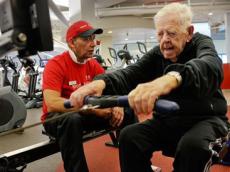|
|
TODAY.AZ / Weird / Interesting
Young soul under old appearance
16 March 2013 [11:45] - TODAY.AZ
 It wasn’t the toll from lugging a heavy tool box to work that finally sent Ray Clark to the gym. It was something more profound. He lost his wife of 67 years. Then he lost his daughter. He was looking for something to fill the empty hours.
It wasn’t the toll from lugging a heavy tool box to work that finally sent Ray Clark to the gym. It was something more profound. He lost his wife of 67 years. Then he lost his daughter. He was looking for something to fill the empty hours.“I was getting a little lazy at home, and I decided I’d go down to the exercise club,” he recalled.
That was more than three years ago, when Clark was 98. As he turned 102 last week, Clark was able to curl
40 pounds, work out vigorously on a rowing machine and deftly pluck bouncing eight-pound kettle bells from the air with the hand-eye coordination of a much younger man.
“He’s a tenacious son of a gun,” said Thom Hunter, Clark’s 70-year-old personal trainer at the Sport&Health club in the Lakeforest section of Gaithersburg. “They built them tougher in those days. He doesn’t say he can’t do it until he tries and sees he can’t.”
In a single 151-pound package, Clark embodies some of the greatest hopes and concerns that public health experts have for the fitness and health of the “older old,” the growing population of people over 85. Clark has significantly improved his strength, balance, endurance and range of motion over the past three years, staving off frailty, possibly saving untold medical costs and proving that gains can be made at any age.
But there are far too few like him.
According to the National Institute on Aging, only 11 percent of people 85 and older engage in any regular exercise, despite clear evidence that the vast majority could work out safely, particularly if shown how. Fewer than 15 percent of people 65 and older do any regular strength training, at a time in life when sarcopenia — the natural decline in muscle mass and strength — contributes to some of the most troubling, and preventable, conditions of old age.
“If I had to do only one thing for the frail older person, it would clearly be weightlifting exercises, and not any other form of exercise,” said Maria Fiatarone Singh, a professor at the University of Sydney School of Medicine, who has been studying the value of strength exercises for the elderly for the past quarter of a century.
In 1988, Singh and her colleagues put older people who were in nursing homes on an “intense” (for them) resistance program and soon doubled and tripled their strength. In 2003, another of her studies showed that a year of weightlifting after a hip fracture — one of the most debilitating injuries of the very old — reduced nursing home admissions and mortality by more than 80 percent compared with other therapies. In 2012, a program of balance exercises and strength training significantly reduced falls among older people, according to another of her studies.
Singh said she believes that more than 80 percent of people 85 and older could safely work out, and Tom Prohaska, dean of the College of Health and Human Services at George Mason University, said studies show that 95 percent of all older people can safely exercise, including those with arthritis, hypertension and heart disease.
/The Washington Post/
URL: http://www.today.az/news/interesting/120415.html
 Print version
Print version
Views: 1926
Connect with us. Get latest news and updates.
See Also
- 19 February 2025 [22:20]
Visa and Mastercard can return to Russia, but with restrictions - 05 February 2025 [19:41]
Japan plans to negotiate with Trump to increase LNG imports from United States - 23 January 2025 [23:20]
Dubai once again named cleanest city in the world - 06 December 2024 [22:20]
Are scented candles harmful to health? - 23 November 2024 [14:11]
Magnitude 4.5 earthquake hits Azerbaijan's Lachin - 20 November 2024 [23:30]
Launch vehicle with prototype of Starship made its sixth test flight - 27 October 2024 [09:00]
Fuel prices expected to rise in Sweden - 24 October 2024 [19:14]
Turkiye strikes terror targets in Iraq and Syria - 23 October 2024 [23:46]
Kazakhstan supplied almost entire volume of oil planned for 2024 to Germany in 9 months - 23 October 2024 [22:17]
Taiwan reported passage of Chinese Navy aircraft carrier near island
Most Popular
 ANCA has made another attempt to put pressure on Trump: The Theater of the absurd
ANCA has made another attempt to put pressure on Trump: The Theater of the absurd
 Brazil launches Amazon transport alliance
Brazil launches Amazon transport alliance
 Armenian passion for Kazakh wheat
Armenian passion for Kazakh wheat
 Azerbaijani literature section opens at Albanian National Library
Azerbaijani literature section opens at Albanian National Library
 Kazakhstan proposes age limits for social media
Kazakhstan proposes age limits for social media
 Azerbaijani companies participate in Turkmentel-2025 International Exhibition in Ashgabat
Azerbaijani companies participate in Turkmentel-2025 International Exhibition in Ashgabat
 President Ilham Aliyev dismisses head of Goygol District Executive Power
President Ilham Aliyev dismisses head of Goygol District Executive Power
